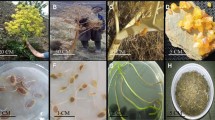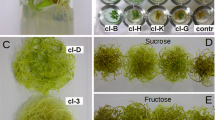Abstract
A reliable and efficient hairy root induction system for the important medicinal plant Callerya speciosa was established by optimizing several parameters that affected the efficiency of Agrobacterium rhizogenes-mediated transformations. Four strains, A4, LBA9402, R1601 and C58C1, and four types of explants, hypocotyls, cotyledons, leaves and excised stems, were examined and the highest rate of transformation (68.3 %) was obtained in cotyledons using strain LBA9402. Therefore, the optimum co-cultivation time and acetosyringone (AS) concentration were evaluated for LBA9402-infected cotyledons and determined to be 2 days and 100 µM AS, respectively, resulting in 64.4 and 66.7 % hairy root transformation efficiency rates, respectively. Transgenic hairy root lines were confirmed by PCR amplification and Southern blot. The growth trend of hairy roots was “slow-quick-slow” and peaked after 30 days of culturing, with increases of 11-fold and 11.4-fold of fresh and dry weights respectively, compared with initial inoculation. Hairy roots showed the ability to synthesize polysaccharides. The effects of different media Murashige and Skoog (MS), ½ MS, WPM and B5, and carbon sources, sucrose, glucose, fructose and maltose on the growth and polysaccharide production of hairy roots were also studied. The ½ MS medium was found to be superior, resulting in the highest accumulation of biomass (10.9 g L−1 fresh weight and 1.1 g L−1 dry weight), the maximum growth index (9.96) and polysaccharide content (22.56 mg g−1 dry weight). Sucrose at 30 g L−1 was optimal for both biomass accumulation and polysaccharide production.






Similar content being viewed by others
Abbreviations
- 6-BA:
-
6-Benzyladenine
- MS:
-
Murashige and Skoog
- NAA:
-
a-Naphthaleneacetic acid
- AS:
-
Acetosyringone
- Cef:
-
Cefotaxime
- YEB:
-
Yeast extract broth
- YMB:
-
Yeast mannitol broth
- PCR:
-
Polymerase chain reaction
References
Ahmed AB, Rao AS, Rao MV, Taha RM (2012) Production of gymnemic acid depends on medium, explants, PGRs, color lights, temperature, photoperiod, and sucrose sources in batch cultures of Gymnema sylvestre. Sci World J 2012:897867
Ashraf MF, Zain CRCM, Zainal Z, Noor ZM, Anuar N, Markom M, Ismail I (2015) Establishment of Persicaria minor hairy roots and analysis of secreted β-caryophyllene in medium broth. Plant Cell, Tissue Organ Cult 121(1):11–20
Cardillo AB, Giulietti AM, Palazon J, Bonfill M (2013) Influence of hairy root ecotypes on production of tropane alkaloids in Brugmansia candida. Plant Cell, Tissue Organ Cult 114(3):305–312
Cheruvathur MK, Thomas TD (2014) Effect of plant growth regulators and elicitors on rhinacanthin accumulation in hairy root cultures of Rhinacanthus nasutus (L.) Kurz. Plant Cell, Tissue Organ Cult 118(1):169–177
Danphitsanuparn P, Boonsnongcheep P, Boriboonkaset T, Chintapakorn Y, Prathantruarug S (2012) Effects of Agrobacterium rhizogenes strains and other parameters on production of isoflavonoids in hairy roots of Pueraria candollei Grah. ex Benth. var. candollei. Plant Cell, Tissue Organ Cult 11(3):315–322
Dubrovina AS, Manyakhin AY, Zhuravlev YN, Kiselev KV (2010) Resveratrol content and expression of phenylalanine ammonia-lyase and stilbene synthase genes in rolC transgenic cell cultures of Vitis amurensis. Appl Microbiol Biotechnol 88(3):727–736
Fu CX, Xu YJ, Zhao DX, Ma FS (2006) A comparison between hairy root cultures and wild plants of Saussurea involucrata in phenylpropanoids production. Plant Cell Rep 24(12):750–754
Furner IJ, Huffman GA, Amasino RM, Garfinkel DJ, Gordon MP, Nester EW (1986) An Agrobacterium transformation in the evolution of the genus Nicotiana. Nature 319(6052):422–427
Gai QY, Jiao J, Luo M, Wang W, Ma W, Zu YG, Fu YJ (2015) Establishment of high-productive Isatis tinctoria L. hairy root cultures: a promising approach for efficient production of bioactive alkaloids. Biochem Eng J 95:37–47
Geier T, Eimert K, Scherer R, Nickel C (2008) Production and rooting behaviour of rolB-transgenic plants of grape rootstock ‘Richter 110’ (Vitis berlandieri x V. rupestris). Plant Cell, Tissue Organ Cult 94(3):269–280
Geng L, Niu L, Gresshoff PM, Shu C, Song F, Huang D, Zhang J (2012) Efficient production of Agrobacterium rhizogenes-transformed roots and composite plants in peanut (Arachis hypogaea L.). Plant Cell, Tissue Organ Cult 109(3):491–500
Grishchenko OV, Kiselev KV, Tchernoded GK, Fedoreyev SA, Veselova MV, Bulgakov VP, Zhuravlev YN (2013) The influence of the rolC gene on isoflavonoid production in callus cultures of Maackia amurensis. Plant Cell, Tissue Organ Cult 113(3):429–435
Henzi MX, Christey MC, McNeil DL (2000) Factors that influence Agrobacterium rhizogenes mediated transformation of broccoli (Brassica oleracea L. var. italica). Plant Cell Rep 19(10):994–999
Hooykaas PJJ, Klapwijk PM, Nuti MP, Shilperoot RA, Horsch A (1977) Transfer of the Agrobacterium tumefaciens Ti plasmid to avirulent Agrobacterium and to Rhizobium ex planta. J Gen Microbiol 98(2):477–484
Inoguchi M, Ogawa S, Furukawa S, Kondo H (2003) Production of an allelopathic polyacetylene in hairy root cultures of goldenrod (Solidago altissima L.). Biosci, Biotechnol and Biochem 67(4):863–868
Jeong GT, Park DH, Ryu HW, Lee WT, Park K, Kang CH, Hwang B, Woo JC (2002) Optimum conditions for transformed Panax ginseng hairy roots in flask culture. Appl Biochem Biotechnol 98–100:1129–1139
Khanuja SPS, Shasany AK, Darokar MP, Kumar S (1999) Rapid isolation of DNA from dry and fresh samples of plants producing large amounts of secondary metabolites and essential oils. Plant Mol Biol Rep 17(1):1–7
Kumar V, Desai D, Shriram V (2014) Hairy root induction in Helicteres isora L. and production of diosgenin in hairy roots. Nat Prod Bioprospect 4:107–112
Lai F, Wang Z, Wang J, Yan X (2009) Analysis of liposoluble components of the leaves from Millettiae Speciosae by GC-MS. Chin J Trop Crops 30(5):714–717
Liu DD, Tang LH, Wang Y, Xiao XJ, Liu LF, Ye MR (2009) Experimental study on the expectorant, antitussive and antiasthmatic effects of radix Millettiae Speciosae. J Guangzhou Univ Tradit Chin Med 26(3):266–269
Lourenco PML, Castro SD, Martins TM, Clemente A, Domingos A (2002) Growth and proteolytic activity of hairy roots from Centaurea calcitrapa: effect of nitrogen and sucrose. Enzyme Microb Technol 31(3):242–249
Lv Z, Zhang S, Lv F, Yang S (2014) Establishment of culture system of Atractylodes japonica Koidz. Ez Kitam. hairy roots and determination of polysaccharide. Chin Pharm J 49(16):1386–1392
Matveeva TV, Sokornova SV, Lutova LA (2015) Influence of Agrobacterium oncogenes on secondary metabolism of plants. Phytochem Rev 14(3):541–554
Mehrotra S, Rahman LU, Kukreja AK (2010) An extensive case study of hairy-root cultures for enhanced secondary metabolite production through metabolic pathway engineering. Biotechnol Appl Biochem 56(4):161–172
Nagella P, Thiruvengadam M, Jung SJ, Murthy HN, Chung IM (2013) Establishment of Gymnema sylvestre hairy root cultures for the production of gymnemic acid. Acta Physiol Plant 35(1):3067–3073
Ono NN, Tain L (2011) The multiplicity of hairy root cultures: prolific possibilities. Plant Sci 180(3):439–446
Pan Y, Zhang X, Meng P, Yu W, Chen S, Tang J, Huang S, Zou Y (2010) Tissue culture of medicinal plant Millettia spciosa Champ. Guangxi Agric Sci 41(6):523–525
Pharmacopoeia Commission of P.R. China (2010) Pharmacopoeia of the People’s Republic of China, (Chinese edition). China Medical Science and Technology Press, Beijing
Piatczak E, Krolicka A, Wysokniska H (2006) Genetic transformation of Centaurium erythraea Rafn. by Agrobacterium rhizogenes and the production of secoiridoids. Plant Cell Rep 25(12):1308–1315
Shakti M, Manoj KG, Vikas S, Laiq UR (2015) Hairy root biotechnology of Rauwolfia serpentina: a potent approach for the production of pharmaceutically important terpenoid indole alkaloids. Biotechnol Lett 37(2):253–263
Sharafi A, Sohi HH, Mousavi A, Azadi P, Razavi K, Ntui VO (2013) A reliable and efficient protocol for inducing hairy roots in Papaver bracteatum. Plant Cell, Tissue Organ Cult 113(1):1–9
Sheikholeslam SN, Weeks DP (1987) Acetosyringone promotes high efficiency transformation of Arabidopsis thaliana explants by Agrobacterium tumefaciens. Plant Mol Biol 8(4):291–298
Shi Y, Gong XX, Na J (2008) Immunoregulatory effects of polysaccharide on immunosuppressed mice. Clin J Med Off 36(4):530–532
Shi HP, Long YY, Sun TS, Tsang PKE (2011) Induction of hairy roots and plant regeneration from the medicinal plant Pogostemon cablin. Plant Cell, Tissue Organ Cult 107(2):251–260
Shinde AN, Malpathak N, Fulzele DP (2010) Impact of nutrient components on production of the phytoestrogens daidzein and genistein by hairy roots of Psoralea corylifolia. J Nat Med 64(3):346–353
Sivakumar G, Yu KW, Hahn EJ, Paek KY (2005) Optimization of organic nutrients for ginseng hairy roots production in large scale bioreactors. Curr Sci 89(4):641–649
Somers DA, Samac DA, Olhoft PM (2003) Recent advances in legume transformation. Plant Physiol 131(3):892–899
Stachel SE, Messens E, Montagu MV, Zambryski P (1985) Identification of the signal molecules produced by wounded plant cells that activate T-DNA transfer in Agrobacterium tumefaciens. Nature 318(6047):624–629
Sudha CG, Sherina TV, Anand VP, Reji JV, Padmesh P, Sonia EV (2012) Agrobacterium rhizogenes mediated transformation of the medicinal plant Decalepis arayalpathra and production of 2-hydroxy-4-methoxy benzaldehyde. Plant Cell, Tissue Organ Cult 112(2):217–226
Venkatachalam L, Bhagyalakshmi N (2008) Morphometric and biochemical characterization of red beet (Beta vulgaris L.) hairy roots obtained after single and double transformations. Plant Cell Rep 27(6):1039–1052
Vervliet G, Holsters M, Teuchy H, Van Montagu M, Schell J (1975) Characterization of different plaque-forming and defective temperate phages in Agrobacterium strains. J Gen Virol 26(1):33–48
Wang Z, Lai F, Wang M, Wang J (2011) Chemical constituents of the roots of Millettia speciosa. Chin J Trop Crops 32(12):2378–2380
Wang CW, Chen GY, Song XP, Chen WH, Shu HM, Han CR, Ji MH (2014) Chemical constituents from roots of Millettia speciosa. Chin Herb Med 45(11):1515–1521
Wei Y, Ma X, Dong Q, Wei K, Li C, Bai L (2012) Study on in vitro culture and plant regeneration of Milletia speciosa. Hubei Agric Sci 51(23):5499–5502
Wu J, Kong J, Wang Y, Han Z, Xu X (2008) Agrobacterium rhizogenes mediated transformation and hairy root regeneration of Malus baccata (L.) Borkh. Acta Horticult Sinica 35:959–966
Wu ZY, Raven Peter H, Hong DY (2010) Flora of China. In: Wei Z, Pedley L (eds) Callerya. Science Press/Missouri Botanical Garden Press, Beijing/St. Louis, pp 182–183
Yin T, Tu GZ, Zhang QY (2008) Three new phenolic glycosides from the caulis of Millettia speciosa. Magn Reson Chem 46(4):387–391
Yu S, Kwok KH, Doran PM (1996) Effect of sucrose, exogenous product concentration, and other culture conditions on growth and steroidal alkaloid production by Solanum aviculare hairy roots. Enzyme Microb Technol 18(4):238–243
Zhang SY, Yin T, Ling XM, Liang H, Zhao YY (2008) Interactions between thrombin and natural products of Millettia speciosa Champ. using capillary zone electrophoresis. Electrophoresis 29(16):3391–3397
Zheng YQ (2009) Studies on extract techniques and pharmacological activities of polysaccharide from Millettia Speciosa Champ. Dissertation, University of Jinan
Zhou TN, Liu DD, Tang LH, Wang Y, Liu LF, Lai P, Xiao XJ, Ye MR (2009) Experimental study on hepatic-protective effects of raidx Millettiae Speciosae. Lishizhen Med Mater Med Res 20(10):2585–2587
Acknowledgments
This work was supported by a grant from the Guangxi Natural Science Foundation of China (No. 2013GXNSFBA019173) and Guangxi Science Committee Projects of China (Nos. 14124002-2 and 20133032-5). The authors would like to thank Dr. Dev Sooranna, Imperial College London, for editing the manuscript.
Author's contributions
L. B. designed the experimental procedures and revised the manuscript. S. Y. conducted the induction, identification and growth of hairy roots; the determination of different parameters; the measurement of FW, DW and polysaccharide; and analyzed the data and wrote the manuscript. Z. L. performed the experiments regarding to bacterial strain culturing. Y. Z. and H. H. cultured the plants. R. W. and T. M. performed the PCR amplification and Southern blot. All of the authors read and approved the final manuscript.
Author information
Authors and Affiliations
Corresponding author
Rights and permissions
About this article
Cite this article
Yao, Sc., Bai, Lh., Lan, Zz. et al. Hairy root induction and polysaccharide production of medicinal plant Callerya speciosa Champ.. Plant Cell Tiss Organ Cult 126, 177–186 (2016). https://doi.org/10.1007/s11240-016-0988-3
Received:
Accepted:
Published:
Issue Date:
DOI: https://doi.org/10.1007/s11240-016-0988-3




